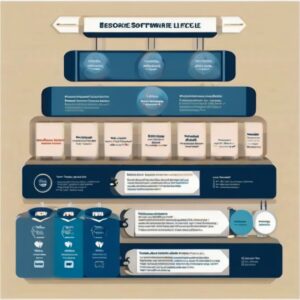Developing custom mobile applications is an intricate process that demands meticulous planning and execution. As a seasoned Mobile Development specialist, I’ll guide you through the lifecycle of creating a tailored software solution. This journey is about crafting a unique digital tool that fits your operational needs like a glove.
Understanding Bespoke Mobile Solutions
Bespoke mobile solutions are tailored software applications that are meticulously crafted to serve the unique needs of a business, organization, or a niche group of users. They go beyond the capabilities of generalized, off-the-shelf mobile applications by offering personalized experiences and features that are aligned with the specific workflows, processes, or services of the entity they are created for. These custom solutions prioritize a deep understanding of the user requirements and business challenges to ensure the final product not only fits seamlessly within the existing technology ecosystem but also enhances operational efficiency and user engagement.
The development of a bespoke mobile app typically starts with a thorough analysis of the business’s needs, including its target audience, operational bottlenecks, and long-term objectives. It involves close collaboration between developers and the business stakeholders to ensure that every feature is relevant and adds value. Since these applications are built from scratch, there’s a high degree of flexibility in design and functionality, enabling developers to incorporate advanced features, such as artificial intelligence, augmented reality, or customized data analytics, that are specifically designed to help the business gain a competitive advantage or improve user satisfaction.
Bespoke mobile solutions are scalable and adaptable to changing business environments or user needs. This means that as a business grows or as market conditions evolve, the application can be modified or expanded accordingly, without the need for a complete overhaul or replacement. This stands in contrast to off-the-shelf apps, which may become obsolete or require significant workarounds as a business evolves.
Bespoke mobile solutions offer a strategic investment for businesses seeking to leverage mobile technology to its fullest potential, providing an app that is not only highly relevant and effective at launch but continues to deliver value and adapt to the evolving landscape of business and technology.
The Discovery Phase
Every successful project starts with a discovery phase. This initial step is paramount for aligning stakeholders’ aspirations with practical possibilities.
Begin by identifying the overriding goal for your app. Why is it needed, and what problems will it solve?
Understanding your end-users is crucial. What do they desire in an app? How will they interact with it?
Analyze your competition. Determine what exists in the market and identify gaps your application could fill.
Produce a comprehensive list of what your application must accomplish. This helps avoid scope creep later.
The Design Phase
Design it’s about crafting an intuitive and engaging user experience (UX).
Develop personas representing your typical users to guide your design decisions.
Visualize the steps users will take within the app, focusing on simplifying and optimizing their interactions.
Build interactive wireframes or prototypes to test and refine your concepts, ensuring that the flow feels natural and the navigation is intuitive.
The user interface (UI) must be visually appealing and align with your brand. Consistency in colors, typography, and iconography contributes to a cohesive experience.
The Development Phase
With designs in hand, it’s time to build. This phase is the heart of the mobile development lifecycle.
Choose the Right Technology Stack. Select languages, frameworks, and tools that align with your goals and resources. Native, web, or hybrid applications each have advantages and potential drawbacks.
An agile methodology allows for iterative development, enabling teams to adapt quickly to changes or new insights.
Implementing thorough quality assurance (QA) testing throughout development is non-negotiable. This ensures that the app functions smoothly across various devices and operating systems.
Any application handling user data must prioritize security. Implement the latest security protocols to safeguard sensitive information.
The Deployment Phase
Deploying an app is more than just uploading it to the App Store or Google Play. It’s about ensuring a smooth transition for users.
Beta testing with a real audience can unearth issues you didn’t find during development.
Use marketing campaigns to drum up excitement and anticipation for the application’s release.
Upon release, closely watch how your app performs. Analytics tools are vital for understanding user behavior and identifying areas for improvement.
User feedback is invaluable. Address concerns promptly and make necessary adjustments.
The Maintenance Phase
The job isn’t finished post-launch. Maintaining and updating your application is essential for its longevity.
Factor in time and budget for regular updates to keep the application fresh and functional.
Ensure your architecture can handle increased user numbers or data loads as your audience grows.
The tech world is fast-paced. What’s in vogue today may be outdated tomorrow. Keep a keen eye on new trends and consider how they might enhance your app’s future.
The Evolution Phase
An app must evolve to stay useful and engaging. Use insights gathered from user data to refine and expand your application.
Adding new features keeps users engaged and offers additional value.
Consider additional services or integrations that could complement your app.
Periodic reassessment of your app’s effectiveness and relevance in the market can inform strategic pivots or updates.
